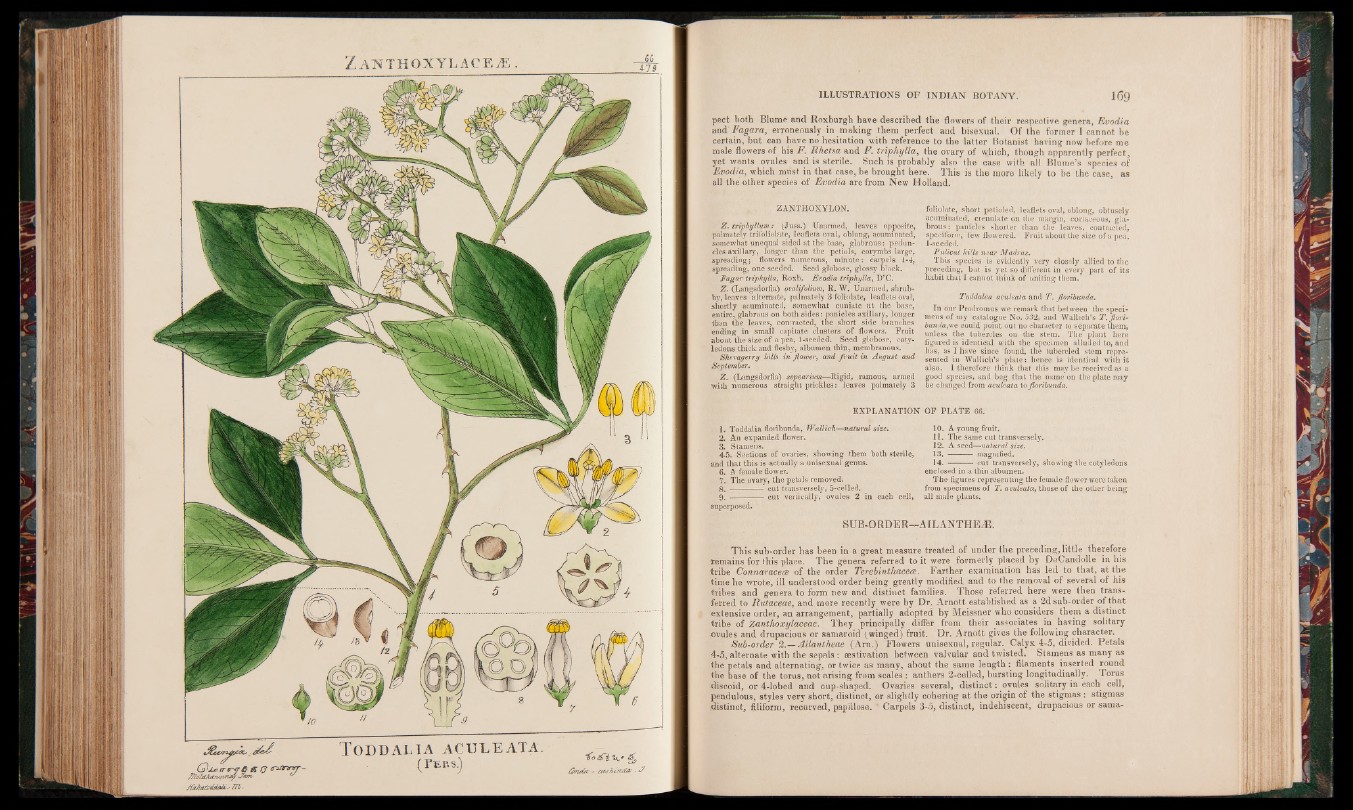
pect both Blume and Roxburgh have described the flowers of their respective genera, Evodia
and Fagara, erroneously in making them perfect and bisexual. Of the former I cannot be
certain, but can have no hesitation with reference to the latter Botanist having now before me
male flowers of his F. Rhetsa and F. triphylla, the ovary of u;hich, though apparently perfect,
yet wants ovules and is sterile. Such is probably also the case with all Blume’s species of
Evodia, which must in that case, be brought here. This is the more likely to be the case, as
all the other species of Evodia are from New Holland.
ZANTHOXYLON.
Z . triphyllum: (Jus's.) Unarmed, leaves opposite,
palmately trifoliolate, leaflets oval, oblong, acuminated,
somewhat unequal sided at the base, glabrous: peduncles
axillary, longer than the petiols, corymbs large,
spreading; flowers numerous, minute: carpels 1-4,
spreading, one seeded. Seed globose, glossy black.
Fagar triphylla, Roxb. Evodia triphylla, D’C.
Z . (Langsdorfia) ovalifolium, R. W. Unarmed, shrubby,
leaves alternate, palmately 3 foliolate, leaflets oval,
shortly acuminated, somewhat cuniate at the base,
entire, glabrous on both sides: panicles axillary, longer
than the leaves, contracted, the short side branches
ending in small capitate clusters of flowers. Fruit
about the size of a pea, 1-seeded. Seed globose, cotyledons
thick and fleshy, albumen thin, membranous.
Shevagerry hills in flower, and f r u i t in August and
September.
Z . (Langsdorfia) sepearium—Rigid, ,ramous, armed
with numerous straight prickles: leaves palmately 3
foliolate, short petioled, leaflets oval, oblong, obtusely
acuminated, crenulate on the margin, coriaceous, glabrous
: panicles shorter than the leaves, contracted,
speciform, few flowered. Fruit about the size of a pea,
1-seeded.
Pulicat hills near Madras.
This species is evidently very closely allied to the
preceding, but is yet so different in every part of its
habit that I cannot think of uniting them.
Toddalea aculeata and T . floribunda.
In our Prodromus we remark that between the specimens
of my catalogue No. 532, and Wallich’s T. floribunda,
we could point out no character to separate them,
unless the tubercles on the stem. The plant here
figured is identical with the specimen alluded to, and
has, as I have since found, the tubercled stem represented
in Wallich’s plate; hence is identical with it
also. I therefore think that this may be received as a
good species, and beg that the name on the plate may
be changed from aculeata to floribunda.
EXPLANATION OF PLATE 66.
1. Toddalia floribunda, Wallich—natural size.
2. An expanded flower.
3. Stamens.
4-5.-Sections of ovaries, showing them both sterile,
and that this is actually a unisexual genus.
6. A female flower.
7. The ovary, the petals removed.
8 . ---------- cut transversely, 5-celled.
-9. ------------ cut vertically, ovules 2 in each cell,
superposed.
10. A young fruit.
11. The same cut transversely.
12. A seed—natural size.
13. --------- magnified.
14. --------- cut transversely, showing the cotyledons
enclosed in a thin albumen.
The figures representing the female flower were taken
from specimens of T. aculeata, those o f the other being
all male plants.
SUB-ORDER—AILANTHEdE.
This sub-order has been in a great measure treated of under the preceding, little therefore
remains for this place. The genera referred to it were formerly placed by DeCandolle in his
tribe Connaracece of the order Terebinthacece. Farther examination has led to that, at the
time he wrote, ill understood order being greatly modified and to the removal of several of his
tribes and genera to form new and distinct families. Those referred here were then trans-.
ferred to Rutaceae, and more recently were by Dr. Arnott established as a 2d sub-order of that
extensive order, an arrangement, partially adopted by Meissner who considers them a distinct
tribe of Zanthoxylaceae. They principally differ from their associates in having solitary
ovules and drupacious or samaroid (winged) fruit. Dr. Arnott gives the following character.
: Sub-order 2.—Ailantheae (Arn.) Flowers unisexual, regular. Calyx 4-5, divided. Petals
4-5, alternate with the sepals : aestivation between valvular and twisted. Stamens as many as
the petals and alternating, or twice as many, about the same length: filaments inserted round
the base of the torus, not arising from scales : anthers 2-celled, bursting longitudinally. Torus
discoid, or 4-lobed and cup-shaped. Ovaries several, distinct: ovules solitary in each cell,
pendulous, styles very short, distinct, or slightly cohering at the origin of the stigmas : stigmas
distinct, filiform, recurved, papillose. ' Carpels 3-5, distinct, indehiscent, drupacious or sama